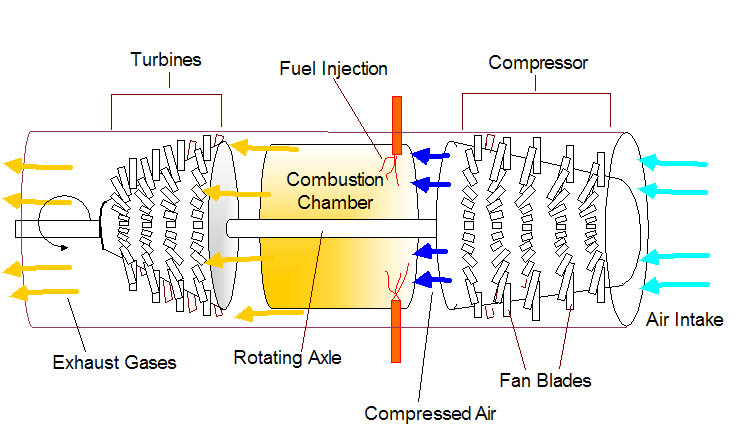Model Jet Engines
Due to advances in model jet engine technology in recent years, radio-controlled jets have become a practical and increasingly affordable reality. This is a good thing, as the dream of private jet ownership remains a dream for most of us.
Jet engines are very simple devices, at least in principle. Every jet engine has three main parts, the Compressor, Combustion Chamber, and Turbines.
The diagram below shows a simple axial-flow jet turbine. Air from the intake is fed through a rotating compressor stage, where a series of fan blades reduces the air volume while increasing the pressure.
The pressure may increase by as much as 30 times.
This compressed air flows into the combustion chamber, where fuel is being continuously injected.
The resulting combustion creates a flow of hot, expanding gases. These gases flow over a turbine with a set of fan blades.
Since the turbine is connected to the compressor by an axle, part of the power of the exhaust gases is used to drive the compressor.
The shaft may be used to drive a machine or generate electricity.
For some engines, there may be a free wheeling turbine stage on its own coaxial shaft, driving a front-mounted fan (turbofan) or propeller (turboprop).

Copyright©2005 RC Airplane Advisor
While this type of engine is simple in principle, the demands on the structures and materials are enormous.
This is perhaps why such a long period of time elapsed from the world's first jet aircraft flight (Hans von Ohain, the Heinkel He 178, in 1939), to the world's first rc jet airplane flight (Jerry Jackman, 1983).
Consider for example one of the model turbine engines produced by AMT, the Pegasus HP.
This engine has a diameter of 4.7 inches, length 10.4 in, and weight 5.9 lb (the full system). This machine produces 35 lb thrust with max rpm 120,000.
The idle speed is 37,000 rpm, larger than the top speed of most two-stroke glow engines! The normal exhaust gas temperature is a toasty 1,110 degrees F.
Another example is the JetCat P-70, which is 3-3/4" in diameter, weighs just 2.6 pounds and produces 16.4 Lbs of thrust.
To start the engine, compressed air or an electric motor may be used. Fuel is propane gas at lower rpm, followed by kerosene for higher exhaust temperature and rpm. All of the functions can be controlled electronically.
These engines sound just like the turbines on modern jet airplanes, and can propel models to speeds well in excess of 200 mph.
An rc jet airplane is definitely a high-performance aircraft. These engines are often used in very realistic, larger scale military and commercial jet rc models.
While this type of model was virtually unheard of a couple decades ago, now there are many engines, models and even flying events dedicated to jets.
Some of the vendors and manufacturers include: Jet Model Products, BVMjets, AMT and JetCat.

